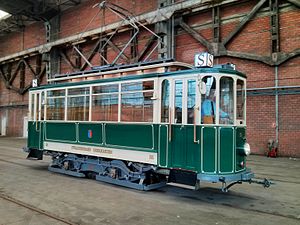Railcar 14–31 (Oberhausen tram)
| Tw 14–31 (Oberhausen) | |
|---|---|
|
Museum car 25 in the MVG depot
|
|
| Numbering: | 14-31 |
| Number: | 18th |
| Manufacturer: |
Herbrand (car body) , Weyer (underframe) , S&H (el. Equipment) |
| Year of construction (s): | 1899/1900 |
| Gauge : | 1000 mm ( meter gauge ) |
| Length over coupling: | 9200 mm |
| Length: | 7700 mm (length over sheet metal, new) 7850 mm (length over sheet metal, conversion) |
| Height: | 3300 mm (car body) 3600 mm (including pantograph) |
| Width: | 1950 mm (new) 2050 m (renovation) |
| Total wheelbase: | 2000 mm |
| Continuous output : | 2 × 30 hp |
| Power transmission: | Overhead line |
| Number of traction motors: | 2 |
| Seats: | 18th |
| Floor height: | 750 mm (platforms) 890 mm (passenger compartment) |
The railcars 14–31 were a series of 18 vehicles from the Oberhausen tram . The meter-gauge railcars were built by the Herbrand wagon factory from 1899 and supplemented the ten railcars and three sidecars of the original equipment from 1897.
development
The second series railcars were procured from 1899. Compared to the first series, the cars were about 30 centimeters longer. The 18 seats were arranged in the transverse direction 2 + 1. They had semi-open entry platforms ; the front wall sides were glazed and offered the driver protection from bad weather, the entrances, however, were still open and were only locked with a chain. The vehicles initially had two entrances on each side at the ends of the vehicle. Before the First World War , the wagons underwent a first conversion in which the front right door was locked. As a result, passengers only had one joint boarding and alighting, which significantly extended their stay at the stops.
In the 1920s, the cars were mainly used as advertising cars , which resulted in heavy wear and tear on the superstructure. Therefore, at the end of the 1920s, another renovation took place in which the superstructures were fundamentally overhauled. The platforms were then completely closed and again had doors on both sides. The sliding doors between the platforms and the passenger compartment have been enlarged. In addition, the cars received tilting skylights for better ventilation. A modified window arrangement with five side windows is also known from railcar 22. The external dimensions increased slightly as a result of the renovation.
From the 1930s on, the Oberhausen tram gradually withdrew the railcars from passenger traffic. Cars 14, 18, 28 and 29 ran as sidecars 211-214 after the electrical equipment was removed in 1934. The railcars 15, 16 and 27 came to the Elbing Tramway in 1936 (pl .: Elbląg ). Of the remaining eleven cars, railcars 17 and 19 were eliminated as war losses. In the 1950s, five railcars were used as work cars (Atw), three of which were in service before the Second World War and under new numbers. With the exception of the Atw 152 (ex 25), the vehicles were retired by the mid-1960s.
Museum car 25
A year before the Oberhausen tram was shut down in 1968, the 152 workcar was converted into a museum vehicle. Since then, the car has been presented under its old number 25 in the condition of the second conversion from 1928. For the farewell trip of the tram on October 13, 1968, the Stadtwerke Oberhausen (STOAG) provided the car with a lyre bracket borrowed from Amsterdam .
In 1969 STOAG handed the car over to the Hanover Tram Museum , where it was then located for almost 30 years. In 1997 the vehicle came to Nordhausen for a short time before it returned to Oberhausen on September 10, 1997. It was then restored in a training project by STOAG and the Oberhausen Center for Training and Professional Qualifications. The second maiden voyage took place on December 31, 1999 in Oberhausen.
The railcar is now used by STOAG as a museum tram for special trips and, according to the company, is the oldest tram vehicle in Germany that is approved for the public rail network. The railcar is usually parked in the depot of the Mülheimer VerkehrsGesellschaft .
Web links
- Description on the STOAG website
- 115 years of railcar No. 25 , Festschrift of STOAG, September 2014 (PDF)
- Description at Trampicturebook
- Tram Germany - STOAG - Tw 25 Pictures and information about Tw 25
Individual evidence
- ^ A b c d Klaus Oehlert-Schellberg, Stefan Kunig: Tram in Oberhausen . Kenning Verlag, Nordhorn 2006, ISBN 3-933613-82-5 , p. 69-73 .
- ↑ a b 115 years of railcar no. 25. (PDF) Stadtwerke Oberhausen, accessed on September 9, 2014 .
- ↑ A vigorous old-timer. In: Lokalkompass.de . Retrieved September 9, 2014 .
